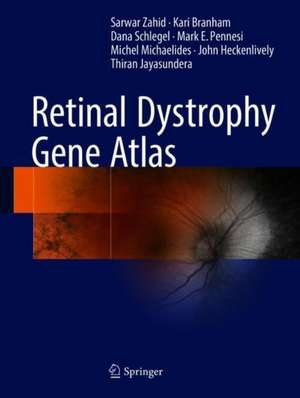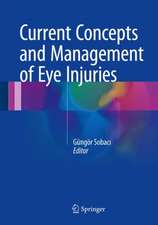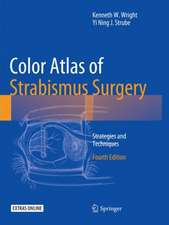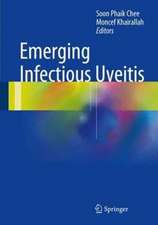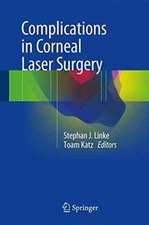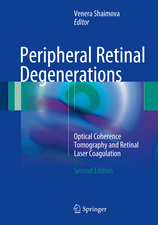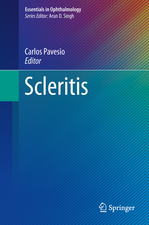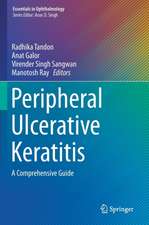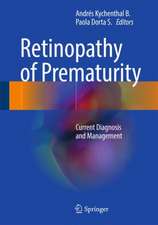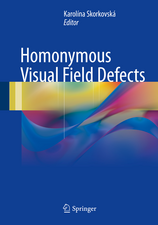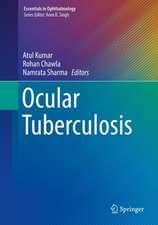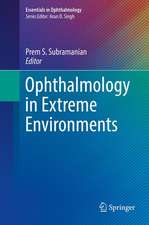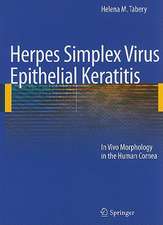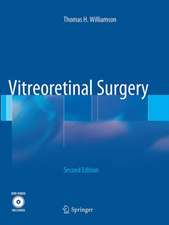Retinal Dystrophy Gene Atlas
Autor Sarwar Zahid, Kari Branham, Dana Schlegel, Mark E. Pennesi, Michel Michaelides, John Heckenlively, Thiran Jayasunderaen Limba Engleză Hardback – 19 iul 2018
| Toate formatele și edițiile | Preț | Express |
|---|---|---|
| Paperback (1) | 1156.81 lei 38-44 zile | |
| Springer International Publishing – 10 dec 2019 | 1156.81 lei 38-44 zile | |
| Hardback (1) | 1318.41 lei 38-44 zile | |
| Springer International Publishing – 19 iul 2018 | 1318.41 lei 38-44 zile |
Preț: 1318.41 lei
Preț vechi: 1387.81 lei
-5% Nou
Puncte Express: 1978
Preț estimativ în valută:
252.31€ • 273.97$ • 211.94£
252.31€ • 273.97$ • 211.94£
Carte tipărită la comandă
Livrare economică 18-24 aprilie
Preluare comenzi: 021 569.72.76
Specificații
ISBN-13: 9783319108667
ISBN-10: 3319108662
Pagini: 330
Ilustrații: XIII, 279 p. 169 illus., 163 illus. in color.
Dimensiuni: 210 x 279 mm
Greutate: 1.17 kg
Ediția:1st ed. 2018
Editura: Springer International Publishing
Colecția Springer
Locul publicării:Cham, Switzerland
ISBN-10: 3319108662
Pagini: 330
Ilustrații: XIII, 279 p. 169 illus., 163 illus. in color.
Dimensiuni: 210 x 279 mm
Greutate: 1.17 kg
Ediția:1st ed. 2018
Editura: Springer International Publishing
Colecția Springer
Locul publicării:Cham, Switzerland
Public țintă
Professional/practitionerCuprins
Part I. Autosomal Dominant Inheritance.- 1. BEST1.- 2. CRX.- 3. CTRP5.- 4. EFEMP1.- 5. ELOVL4.- 6. FSCN2.- 7. GNAT1.- 8. GUCA1A.- 9. GUCA1B.- 10. GUCY2D.- 11. IMPDH1 (RP10).- 12. JAG1.- 13. KLHL7.- 14. PROM1.- 15. PRPF3 (RP18).- 16. PRPF31.- 17. PRPF8 (RP18).- 18. PRPH2 (RDS).- 19. RBP3.- 20. RGR.- 21. RHO.- 22. RLPB1.- 23. RP1.- 24. RIMS1.- 25. SEMA4A.- 26. SNRNP200.- 27. TIMP3.- 28. TOPORS.- 29. TTC8.- 30. VCAN.- 31. WFS1.- Part II. Autosomal Recessive Inheritance.- 32. ABCA4.- 33. AIPL1.- 34. ALMS1.- 35. ARL6.- 36. BBS1.- 37. BBS10.- 38. BBS12.- 39. BBS2.- 40. BBS4.- 41. BBS5.- 42. BBS7.- 43. BBS9.- 44. C2ORF71.- 45. C8ORF37.- 46. CDH23.- 47. CEP290.- 48. CERKL.- 49. CLN3.- 50. CLRN1.- 51. CNGA1.- 52. CNGA3.- 53. CNGB1.- 54. CNGB3.- 55. CRB1.- 56. CYP4V2.- 57. DFNB31.- 58. DHDDS.- 59. EYS.- 60. FAM161A.- 61. GNAT2.- 62. GPR98.- 63. IDH3B.- 64. IMPG1.- 65. IQCB1.- 66. KCNV2.- 67. KCNJ13.- 68. LCA5.- 69. LRAT.- 70. MAK.- 71. MERTK.- 72. MYO7A.- 73. NMNAT1.- 74. NR2E3.- 75. NRL.- 76. OAT.- 77. PDE6A.- 78. PDE6B.- 79. PDE6C.- 80. PDE6G.- 81. PDE6H.- 82. PEX7.- 83. PHYH.- 84. PRCD.- 85. RD3.- 86. RDH5.- 87. RDH12.- 88. RPE65.- 89. RPGRIP1.- 90. SAG.- 91. SPATA7.- 92. TULP1.- 93. USH1C.- 94. USH1G.- 95. USH2A.- 96. ZNF513.- Part III. X-Linked Inheritance.- 97. CACNA1F.- 98. CHM.- 99. NYX.- 100. OPN1LW.- 101. RP2.- 102. RPGR.- 103. RS1.
Notă biografică
Sarwar Zahid, MS, MD
University of Michigan
Kellogg Eye Center
Ann Arbor, MI, USA
Kari Branham, MS, CGC
University of Michigan
Kellogg Eye Center
Ann Arbor, MI, USA
Dana Schlegel, MS, MPH, CGC
University of Michigan
Kellogg Eye Center
Ann Arbor, MI, USA
Mark Pennesi, PhD, MD
Casey Eye Institute
Portland, OR, USA
Michel Michaelides, MB, MD
Moorfields Eye Hospital
London, United Kingdom
John Heckenlively, MD
University of Michigan
Kellogg Eye Center
Ann Arbor, MI, USA
Thiran Jayasundera, MD
University of Michigan
Kellogg Eye Center
Ann Arbor, MI, USA
Textul de pe ultima copertă
Classically, photo atlases of retinal dystrophies have been divided into sections that describe and depict a particular retinal finding or disease, after which a differential diagnosis of potential diseases or mutated genes is provided. However, given the rapid improvement in molecular diagnostics, and the exponential increase in our understanding of the phenotypes caused by each mutated gene, the paradigm has changed. Physicians are now more interested in the variable expressivity associated with mutations in each individual gene. Therefore, Retinal Dystrophy Gene Atlas catalogs the different phenotypes that have been reported with each mutated gene. Each section describes a gene and its known clinical phenotypes and features of disease, along with retinal photos of affected patients. Written by prominent retinal dystrophy specialists from the largest dystrophy centers worldwide, Retinal Dystrophy Gene Atlas contains more than 80 chapters, each of which describes the clinical and photographic manifestations of a specific gene. The chapters include stunning clinical color photographs of the retina, autofluorescence imaging, electrophysiologic findings, and cross-sectional imaging. Retinal Dystrophy Gene Atlas serves as a resource to aid genetic diagnosis in patients with retinal dystrophies.
Caracteristici
Describes a gene and all its possible clinical phenotypes and patient characteristics, along with retinal photos depicting each possible phenotype Written by prominent retinal dystrophy specialists from the largest dystrophy centers worldwide Contains more than 80 chapters, each of which describes the clinical and photographic manifestations of a specific gene Includes stunning clinical color photographs of the retina, autofluorescence imaging, and electrophysiologic findings and cross-sectional imaging Serves as a resource to aid genetic diagnosis in patients with retinal dystrophies by retina specialists and pediatric ophthalmologists in the United States, as well as hundreds of fellows and residents that enter the workforce each year
